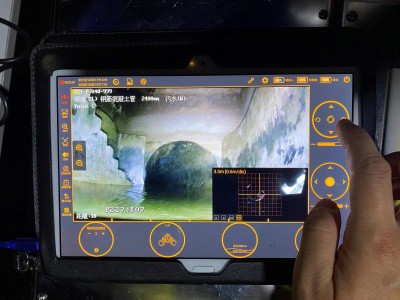Hong Kong’s Drainage Services Department (DSD) has conducted pilot operations of two robots – the river desilting robot and the pipeline inspection robot – to enhance the efficiency and safety of maintenance works on the city’s drainage facilities.
The DSD conducts regular maintenance of these facilities such as river channels and underground pipes. However, maintenance works for drainage facilities are easily affected by weather conditions and tide levels. In addition, limited working spaces in most of the underground drainage facilities constrained the use of large machinery, posing safety risks for workers.

The new river desilting river, introduced in December last year, to remove accumulated silt at a section of the Tuen Mun River under the Tuen Mun MTR Station.
“The robot collects silt by suction, which is similar to the operation of a vacuum cleaner. The operator remotely controls the robot on a temporary working platform via a console,” said a DSD spokesperson. “The silt is located by the closed-circuit television and sonar device installed on the robot and dewatered at the temporary dewatering tank before it is transferred off site."

Compared with the traditional desilting method which requires operators to drive excavators and trucks into the river, the river desilting robot can operate under water regardless of tides and weather conditions. Hence, desilting works can be conducted throughout the year, making desilting operations more flexible and efficient.
The larger suction rate of the river desilting robot enables the collection of more fluid silt as compared with the desilting robot used at box culverts, making it more suitable for the desilting works at rivers.
Meanwhile, the remotely-operated pipeline inspection robot is built to assist in the investigation of the structural integrity and service condition of underground drains, which helps with the maintenance and upgrading of drainage systems in a timely manner.

The pipeline inspection robot is a vessel equipped with a 360-degree high-definition camera and a sonar device. The robot can operate within a drain remotely without flow diversion. The data collected can help with the formulation of desilting and maintenance works. The high-definition camera inspects the condition of the pipeline structure above water level, and the sonar device detects the profile of the siltation.
The pipeline inspection robot completed an inspection with CCTV and sonar of a 1.8-kilometres sewage tunnel in Tseung Kwan O on January 15 this year, breaking the record in Hong Kong.

"The river desilting robot and the pipeline inspection robot can greatly reduce the safety risk of workers by remote operation. The DSD expects the applications of such technology can be further extended to the maintenance works of other rivers and pipelines upon the gathering of data and experience from these trials,” the DSD spokesperson said.
In recent years, heavy rainfall due to extreme weather has become more frequent. Over the last five years, the DSD received an average of 90 flooding reports annually.
Analysis of the flooding reports revealed that the majority of flooding cases were caused by the blockage of drainage intakes by debris such as leaves, sand, gravel or waste, which affected the discharging of surface runoff. Also, part of the flooding cases were the result of tidal caused backwater in low-lying areas. Majority of flooding cases subsided immediately after emergency clearance works conducted by the DSD.



